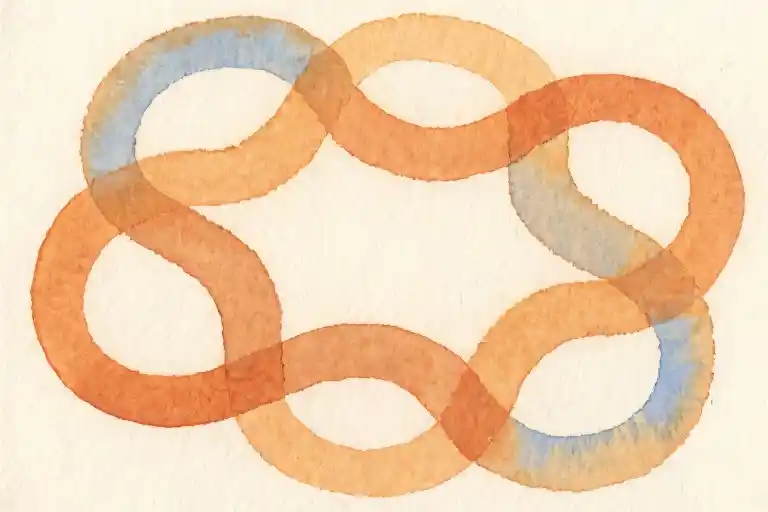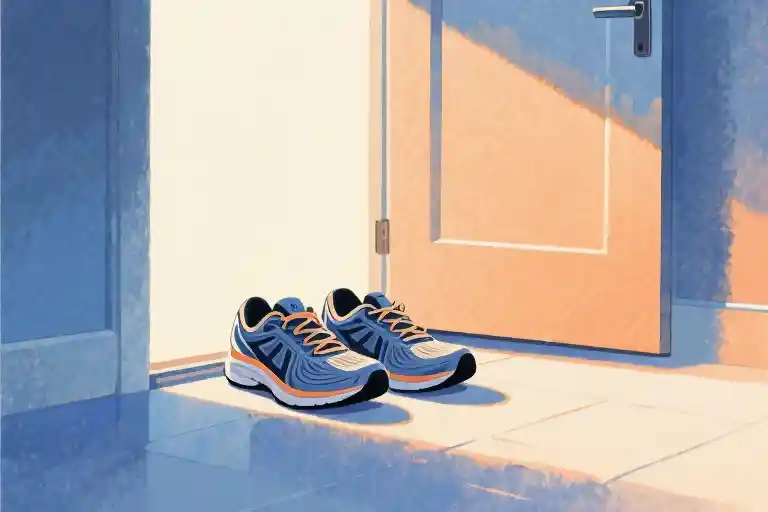The ache arrives before the alarm clock. That unnamed weight pressing against your ribs as you blink awake, already feeling like you’re three steps behind in a race nobody announced. The room looks familiar—same walls, same light through the blinds—but something about the air makes it hard to breathe. Like the world quietly changed the rules while you were sleeping, and now you’re fumbling with the controls of your own life.
When you whisper “I’m not…” to yourself in the mirror, what fills that silence? Not good enough? Not where you should be? Not the person everyone expected? That unfinished sentence hangs over so many of our days, coloring conversations and accomplishments with a tinge of “but.”
What if this stagnation isn’t what it seems? The very fact you notice the distance between where you are and where you want to be proves you haven’t peaked—you’ve simply outgrown your old measuring sticks. Growth isn’t always vertical; sometimes it’s the quiet expansion of roots before the next visible sprout.
Consider the physics of feeling stuck: objects in motion tend to stay in motion, but human momentum works differently. Our forward movement requires both friction and propulsion—the resistance of challenges and the thrust of small, consistent actions. That heavy sensation of treading water? It’s often the prelude to breaking through to a new stroke you didn’t know you could swim.
Your particular flavor of self-doubt—the fear that you’ve already reached your limits—is actually evidence of untapped potential. The ceiling you’re bumping against might just be the floor of a higher level you’re ready to build. Tomorrow’s version of you already knows things today’s self can’t imagine, just as today’s struggles will one day make perfect sense as necessary steps.
So let’s start with this: whatever comes after “I’m not” in your private thoughts, try adding “…yet” just once today. Not as empty positivity, but as an acknowledgment that the story isn’t finished. The same mind that constructs these fears also holds the blueprint for their solution—you simply need to stop comparing your rough sketches to everyone else’s highlight reels.
The Anatomy of Stagnation: When Your Mind Becomes the Room You Can’t Breathe In
That unnamed ache you wake up with—the one that sits heavy on your chest like an uninvited guest—isn’t just fatigue. Neuroscience shows it’s your brain’s smoke alarm going off when it detects a mismatch between where you think you should be and where you actually are. The ‘familiar room’ you’re gasping in? That’s your own psyche rebelling against outdated mental maps.
We’ve all felt it: scrolling through LinkedIn seeing promotions while your own career feels stationary, watching friends hit milestones as your life seems to pause. But here’s what no one tells you—that suffocating sensation isn’t proof you’re failing. It’s evidence your mind is still alive enough to want more.
The Tyranny of Social Clocks
Society hands us invisible timetables—’shoulds’ disguised as natural laws. By 30 you should be established, by 40 you should be thriving. These artificial rhythms create what psychologists call ‘temporal vertigo,’ where the mere passage of time feels like falling behind. A 2023 APA study found 68% of adults experience this as physical distress—tightened chests, shallow breathing—identical to your ‘room that won’t let you breathe.’
But consider this: the average person changes careers 5-7 times now. The linear ladder we imagine? It was always a myth. That colleague who seems ahead may just be on a different path, not a higher one.
Your Brain’s Deceptive Dashboard
When you think ‘I’ve peaked,’ you’re likely trusting faulty mental shortcuts. Our brains are wired to:
- Compare selectively (noticing others’ highlights while seeing our own bloopers)
- Mistake transition for termination (confusing a plateau with a permanent stop)
- Discount gradual progress (your 1% improvements are real, just less visible)
Neuroplasticity research confirms no age cutoff for growth—your potential isn’t shrinking, just waiting for new challenges to activate dormant pathways. That ‘hollow version’ you fear is permanent? It’s actually your psyche’s way of making space for what comes next.
The Liberating Truth About Being ‘Behind’
Progress isn’t a footrace with others—it’s learning to walk your own terrain. Tomorrow, try this:
- When comparison anxiety hits, ask: ‘Who decided this was the finish line?’
- Track backward instead of forward—list skills you’ve gained that your younger self couldn’t imagine
- Redefine ‘moving’ to include internal shifts—not just job changes but perspective expansions
That ache you can’t name? It’s not your expiration date—it’s your becoming trying to break through. The room will feel less suffocating when you stop trying to breathe someone else’s air.
The Myth of Peaking: Why Your Best Isn’t Behind You
That gnawing fear that you’ve already peaked—that the best versions of yourself exist only in rearview mirrors—is perhaps one of the most brutal lies our anxiety tells us. We’ve all had those moments staring at LinkedIn updates or Instagram stories, watching peers celebrate milestones while we’re still untangling the same knots we carried last year. But here’s what career development research reveals: human potential follows U-curves, not bell curves.
The U-Curve of Reinvention
Consider this: a 15-year Harvard study found that professionals typically experience three to five major competence dips throughout their careers—not because they’re failing, but because they’re leveling up. Each time we step onto a new learning curve, there’s an inevitable period of feeling incompetent. That discomfort isn’t evidence of decline; it’s the friction of growth.
Try this:
- Take any skill you’ve mastered (driving, public speaking, using Excel)
- Map how many times you thought “I’ll never get this” during the process
- Notice where those despair points correlate with eventual breakthroughs
Your Non-Linear Growth Map
Most of us imagine progress as a steady upward slope, but authentic development looks more like:
- Spiral staircases (revisiting similar challenges at higher levels)
- Puzzle pieces (apparently disconnected skills that later interlock)
- Desert highways (long stretches where the scenery doesn’t seem to change)
Exercise: Grab any notebook. Draw two parallel lines representing your life timeline. Above the line, mark events society celebrates (promotions, degrees). Below it, note private growth moments (setting boundaries, overcoming a fear). See how your “below the line” achievements often enable the visible ones.
The Comparison Distortion
When we measure ourselves against others’ highlight reels, we’re making a category error—like comparing our behind-the-scenes footage to their trailer. That colleague who seems lightyears ahead? They’re likely comparing themselves to someone else too. This isn’t motivational fluff; neuroscience shows our brains are wired to notice upward comparisons 3x more than downward ones.
Three reframes when comparison strikes:
- “Different pace ≠ different destination”
- “Their visibility isn’t evidence of my invisibility”
- “I’m seeing their chapter 20 while living my chapter 12”
Potential Isn’t a Limited Resource
The terrifying thought “What if I’ve already peaked?” assumes potential is like a tank of gasoline—finite and depleting. But creativity studies suggest otherwise: our capacity expands through use. Those blank moments when you feel empty? They’re not voids—they’re the necessary reset periods before new growth cycles.
Signs you’re not peaking but preparing:
- Increased sensitivity to what’s not working
- Sudden nostalgia for past phases (your subconscious comparing growth stages)
- Feeling simultaneously restless and stuck (the tension before transformation)
Tonight, try this: Write one sentence completing “I’m not stuck, I’m…” without using negative words. Maybe you’re “recalibrating” or “gathering momentum.” Language shapes reality—and your brain believes what you consistently tell it.
The 5-Minute Breakthrough Experiment: Three Variations of Possibility Journaling
That moment when you stare at a blank page, willing yourself to write something—anything—but your mind keeps circling back to all the reasons why nothing will change. I know that paralysis. The irony isn’t lost on me that the very tool meant to help us move forward can become another reminder of our stuckness when we approach journaling like a performance review.
Variation 1: The ‘What If’ Scaffold
Grab any notebook (receipts, napkins, phone notes—no special stationery required). At the top, write: “Today’s experiment is to imagine three impossible things before breakfast.” Then:
- One wildly impractical idea (“What if I quit and became a lighthouse keeper?”)
- One tiny tweak (“What if I took lunch breaks outside this week?”)
- One identity shift (“What if I acted like someone who believes growth is possible?”)
The magic lies in the pairing—the absurdity of #1 loosens mental constraints, making #2 feel surprisingly doable. A client recently discovered her desire to “work on a flower farm” translated practically into adding plants to her home office.
Variation 2: The Reverse Progress Log
When comparison fatigue hits (“Everyone’s moving while I’m…”), list:
- Three things you can do today that you couldn’t a year ago (“Identify toxic productivity patterns” counts)
- Two skills that have deepened unexpectedly (Even “getting better at resting” qualifies)
- One way your definition of ‘enough’ has evolved
This isn’t positivity toxic. Neuroscience shows recalling past growth literally rewires neural pathways—like showing your brain its own résumé when imposter syndrome strikes.
Variation 3: The Permission Slip
Write this stem: “Today, I give myself full permission to…” followed by:
- One act of purposeful imperfection (“Send that email with 2 typos”)
- One discontinued ‘should’ (“Stop pretending to care about [insert draining activity]”)
- One reclaimed pleasure (“Reread childhood books just because”)
Clients report this variation disrupts the “not enough” script most effectively. One CEO realized her stagnation came from over-polishing every presentation—her breakthrough was deliberately including one unedited slide.
When Action Feels Like Amplifying the Anxiety
That post-journaling panic (“Now I see the problems even clearer!”) is actually progress in disguise. Think of it like stirring up pond water—the murkiness means sediment that’s been sitting stagnant is finally in motion. Here’s how to navigate the discomfort:
- Name the Resistance
Instead of “I’m failing at this too,” try: “My brain is offering protest thoughts about change.” This creates psychological distance from the anxiety. - Schedule Worry Time
If insights from journaling spiral, literally tell yourself: “I’ll revisit this concern at 4pm.” Often, the urgency dissipates. - Look for the Hidden ‘Want’
Underneath “Nothing works” usually lies a quieter truth like “I want to feel purposeful again.” Highlight these in green pen—they’re compass points, not criticisms.
Remember: Feeling worse temporarily often means you’re touching authentic pain points rather than numbing them. One journal entry won’t solve systemic issues, but it can reveal where to gently apply pressure.
The Counterintuitive Next Step
After closing your notebook, resist the urge to immediately “do something” with these insights. Instead, try one of these integration pauses:
- Brew tea while mentally categorizing today’s notes as “seeds” not “to-dos”
- Take a walk without headphones, letting thoughts rearrange themselves
- Physically shake out your limbs—symbolically releasing the need for instant clarity
Growth isn’t about constant motion. Sometimes the most radical action is learning to be still with what arises—trusting that awareness itself is a form of movement.
Building Your Anti-Stagnation System
The ache of feeling stuck often lingers because we treat it as a temporary glitch rather than a systemic issue. That persistent whisper of “Is this all I’ll ever be?” won’t disappear through sheer willpower—it requires rebuilding how we measure progress itself. What if your stagnation isn’t about lacking movement, but about using the wrong compass?
The Tri-Perspective Evaluation Method
Traditional self-assessment fails us during growth plateaus because we’re both the prisoner and the jailer. The tri-perspective method creates necessary distance:
- The Mirror View (Self)
- Instead of asking “Am I enough?” try “What evidence contradicts my fear?”
- Keep a ‘reverse resume’ tracking skills gained through failures
- The Window View (Trusted Others)
- Ask three people who knew you at different life stages: “What growth have you observed that I might be discounting?”
- Note how their observations reveal blind spots in your self-narrative
- The Bird’s-Eye View (Future Self)
- Write a letter from your 80-year-old self analyzing this “stuck” period as a necessary transition
- Identify which current worries will seem irrelevant in five years
This triangulation exposes how stagnation often masquerades as transformation in slow motion. When a client recently used this method, she discovered her “unproductive year” contained 47 micro-skills gained through personal crises—invisible progress that later fueled her career pivot.
Elastic Goal Setting: The SMART-R Framework
Standard SMART goals backfire during stagnation by ignoring psychological realities. The revised SMART-R framework adds Resilience:
- Specific but not rigid: “Read 15 pages daily” becomes “Engage with ideas daily (pages, podcasts, conversations)”
- Measurable with compassion: Track effort hours rather than binary success/failure
- Achievable through “good enough” benchmarks: Complete 3 of 5 weekly actions = victory
- Relevant to current capacity: During low-energy phases, focus on maintenance over growth
- Time-bound with escape hatches: “Try this for two weeks then reassess” prevents guilt spirals
- Resilient by design: Build in “collapse weeks” where doing 20% maintains momentum
The magic lies in the R-factor. One writer battling burnout set a goal to “touch my manuscript daily”—some days that meant writing 2000 words, others just rereading a paragraph. This elasticity created 8 months of unbroken progress after years of stop-start cycles.
The Forbidden List of Goal Setting
Certain approaches guarantee stagnation persistence. Avoid these like quicksand:
- Comparison Contamination: Using others’ milestones as metrics (“They published at 25, so must I”)
- All-or-Nothing Timelines: “If I don’t get promoted this year, I’ve failed”
- Productivity Moralizing: Equating busyness with worth (“I didn’t exercise today = I’m lazy”)
- Nostalgia Traps: “I used to be so motivated” comparisons ignore changed circumstances
- Binary Thinking: “Until I finish this big project, nothing counts” dismissing small wins
A useful test: Does this standard account for who I am now, not who I was or think I should be? Stagnation often stems from fighting phantom versions of ourselves.
Maintaining Your Progress Ecosystem
Like tending a garden, preventing stagnation requires regular systems checks:
- Monthly Perspective Audits: Revisit your tri-perspective evaluations
- Goal Flexibility Reviews: Are current targets still serving you?
- Comparison Detox Days: 24-hour bans on social media or achievement talk
- Progress Archaeology: Dig up forgotten evidence of growth (old journals, emails)
- Future Self Letters: Correspond regularly with your wiser future perspective
Remember: Feeling stuck isn’t proof of failure—it’s evidence your old measures no longer fit who you’re becoming. The ache means you’re outgrowing, not underperforming. What if this hollow season is simply the necessary silence between verses of your life’s song?
The Unfinished Sentence
That lingering “I’m not…” hangs in the air like half-erased chalk marks. We’ve all stood before that blank space, filling it with our private fears: not good enough, not progressing, not who I thought I’d become. But what if we’ve been reading the sentence wrong all along?
This isn’t about completing the thought with another self-judgment. It’s about recognizing that the most powerful stories often live in the ellipses—the unspoken, the unfinished, the still-becoming. When you whisper “I’m not…”, you’re not stating a permanent truth. You’re noticing the gap between where you are and where you hoped to be. And that noticing? That’s the first muscle movement of change.
Today’s Anti-Comparison Task
Before you close this page, do this one small thing:
- Grab any writing tool (phone notes, grocery receipt, the margin of this page)
- Complete the sentence “Today, I resisted comparison when…” with one concrete example
- Did you mute a triggering social account?
- Did you pause before measuring your progress against a colleague’s?
- Did you acknowledge an old fear without letting it steer?
No grand gestures needed. The act of documenting creates a counterweight to that “I’m not…” momentum.
The Question We Never Ask
We spend so much energy trying to prove we’re enough—to bosses, partners, even strangers on the internet. But consider this disarming possibility:
What if ‘enough’ wasn’t something to demonstrate, but something to decide?
Not a finish line to reach, but a permission slip you write yourself daily. Not measured in external milestones, but in the quiet moments when you choose self-compassion over self-flagellation.
So I’ll leave you with this instead of a pep talk: If tomorrow began with the unshakable knowing that you’re already enough—not perfect, not finished, but fundamentally enough as you are—what mundane, marvelous thing would you do first?
Would you finally start that imperfect project? Would you rest without guilt? Would you ask for help unapologetically? The answer doesn’t need to be profound. Often, the most revolutionary acts look ordinary from the outside.
(And if you’re tempted to say “But I wouldn’t know how to believe that,” here’s a secret: You don’t have to believe it yet. Just try writing the permission slip anyway. The believing can catch up later.)





